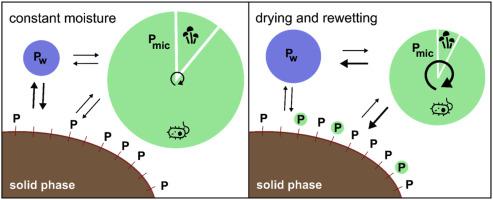Soil Biology and Biochemistry ( IF 9.8 ) Pub Date : 2020-11-23 , DOI: 10.1016/j.soilbio.2020.108079 Hao Chen , Klaus A. Jarosch , Éva Mészáros , Emmanuel Frossard , Xiaorong Zhao , Astrid Oberson

|
Soil drying and rewetting (DRW) events are expected to occur at higher frequencies because of alterations in climate patterns. Readily extractable inorganic and microbial soil phosphorus (P) pools may be affected due to rapid changes in soil water availability. We aimed to determine how soil P dynamics are affected by repeated soil DRW using a sandy grassland soil that regularly experiences DRW. In a laboratory soil incubation study, the soil was exposed to three DRW cycles, with each cycle consisting of a two-day drying phase, a three-day dryness phase and a four-day moist phase after rapid rewetting. The indicators of abiotic processes (P sorption) and biotic processes (respiration, microbial abundance, potential phosphatase enzyme activities) were regularly determined together with water-extractable P, resin-extractable P and microbial P in a 33P-labelled soil.
During the first DRW cycle, microbial P was reduced by half and accompanied by a concomitant but not equivalent increase in water-extractable P and a slight as well as delayed increase in resin-extractable P. Thus, increases in water-extractable P were explained by microbial P released during drying but also by microbial P occupying soil P sorption sites, thereby decreasing soil P sorption. Changes in the 33P-isotopic composition of microbial P at the same time suggested that microorganisms did not respond homogenously to the DRW treatment and indicated an increased mineralisation of previously unavailable organic P compounds. However, during the second and third DRW cycles, only water-extractable P, soil P sorption and potential phosphatase activities were affected by the DRW treatment, whereas all other parameters remained similar in values to the constant moist treatment. The effects of DRW on soil P dynamics appeared to affect water-extractable P more long-lastingly, whereas microbial P and most of the biotic indicators quickly adjusted to the DRW treatment. We conclude that the current concepts suggesting an increased mobility of soil P towards other environmental compartments due to soil DRW should consider that abiotic and biotic soil P dynamics are not equally affected in the case of short repetition of DRW incidences.
中文翻译:

反复干燥和再湿润对沙质土壤中非生物和生物土壤磷(P)动力学的影响不同:一项33 P土壤培养研究
由于气候模式的改变,预计土壤干燥和再润湿(DRW)事件的发生频率更高。由于土壤水分的快速变化,易于提取的无机和微生物土壤磷(P)库可能会受到影响。我们的目的是确定使用定期经历DRW的沙质草地土壤,重复土壤DRW对土壤P动态的影响。在实验室土壤温育研究中,将土壤暴露于三个DRW循环,快速循环后,每个循环包括两天的干燥阶段,三天的干燥阶段和四天的潮湿阶段。定期确定非生物过程(P吸附)和生物过程(呼吸,微生物丰度,潜在的磷酸酶活性)的指标,以及水中的水可萃取P,树脂可萃取P和微生物P。33 P标记的土壤。
在第一个DRW循环中,微生物P减少了一半,并伴随着水提取P的增加(但不等价),以及树脂提取P的微弱和延迟的增加。因此,解释了水提取P的增加在干燥过程中释放的微生物P以及微生物P占据的土壤P吸附位点,从而降低了土壤P的吸附。33的变化同时,微生物P的P同位素组成表明微生物对DRW处理的反应不均一,并表明以前无法获得的有机P化合物的矿化增加。但是,在第二个和第三个DRW循环中,DRW处理仅影响水可萃取的P,土壤P的吸附和潜在的磷酸酶活性,而所有其他参数的值仍与恒定湿润处理相似。DRW对土壤P动力学的影响似乎更持久地影响可水分萃取的P,而微生物P和大多数生物指标很快适应了DRW处理。











































 京公网安备 11010802027423号
京公网安备 11010802027423号